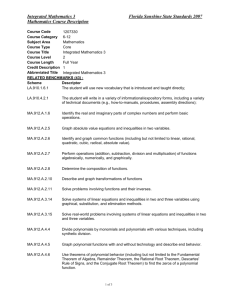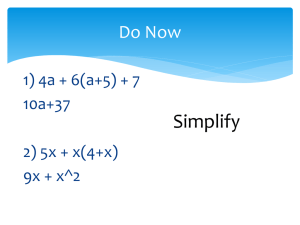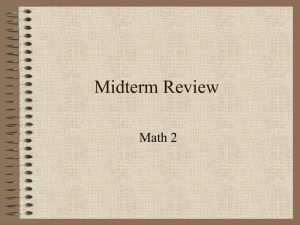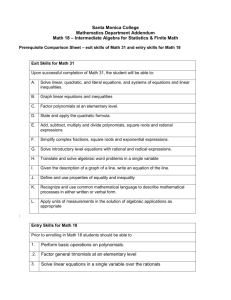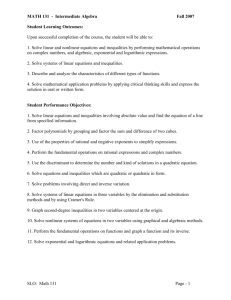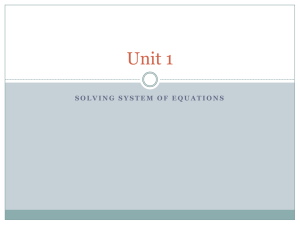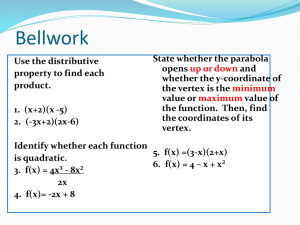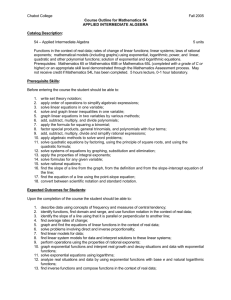Finite Mathematics - Santa Monica College
advertisement
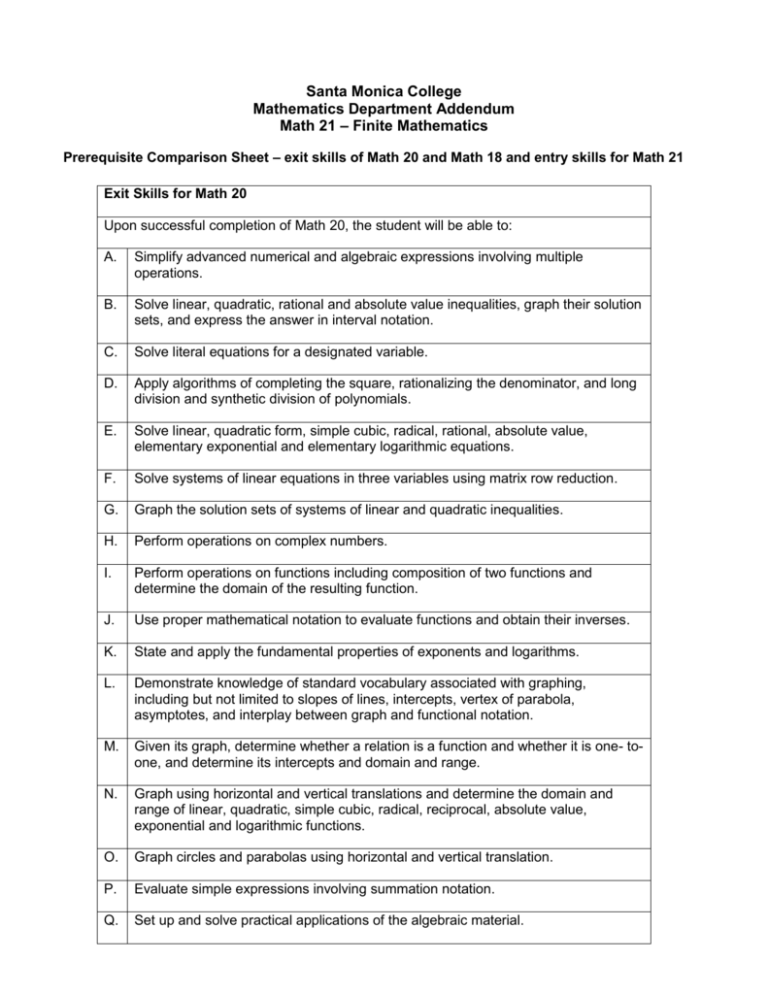
Santa Monica College Mathematics Department Addendum Math 21 – Finite Mathematics Prerequisite Comparison Sheet – exit skills of Math 20 and Math 18 and entry skills for Math 21 Exit Skills for Math 20 Upon successful completion of Math 20, the student will be able to: A. Simplify advanced numerical and algebraic expressions involving multiple operations. B. Solve linear, quadratic, rational and absolute value inequalities, graph their solution sets, and express the answer in interval notation. C. Solve literal equations for a designated variable. D. Apply algorithms of completing the square, rationalizing the denominator, and long division and synthetic division of polynomials. E. Solve linear, quadratic form, simple cubic, radical, rational, absolute value, elementary exponential and elementary logarithmic equations. F. Solve systems of linear equations in three variables using matrix row reduction. G. Graph the solution sets of systems of linear and quadratic inequalities. H. Perform operations on complex numbers. I. Perform operations on functions including composition of two functions and determine the domain of the resulting function. J. Use proper mathematical notation to evaluate functions and obtain their inverses. K. State and apply the fundamental properties of exponents and logarithms. L. Demonstrate knowledge of standard vocabulary associated with graphing, including but not limited to slopes of lines, intercepts, vertex of parabola, asymptotes, and interplay between graph and functional notation. M. Given its graph, determine whether a relation is a function and whether it is one- toone, and determine its intercepts and domain and range. N. Graph using horizontal and vertical translations and determine the domain and range of linear, quadratic, simple cubic, radical, reciprocal, absolute value, exponential and logarithmic functions. O. Graph circles and parabolas using horizontal and vertical translation. P. Evaluate simple expressions involving summation notation. Q. Set up and solve practical applications of the algebraic material. Santa Monica College Page 2 of 4 Exit Skills for Math 18 Upon successful completion of Math 18, the student will be able to: A. Solve linear inequalities in one and two variables, graph their solution sets, and express the answer in interval notation where appropriate. B. Solve literal equations for a designated variable. C. Solve linear, quadratic, exponential and logarithmic equations. D. Solve systems of linear equations using matrix row reduction. E. Graph the solution sets of systems of linear inequalities. F. Given its graph, determine whether a relation is a function and whether it is one-toone, and determine its intercepts and domain and range. G. Graph and determine the domain and range of linear, quadratic, exponential and logarithmic functions. H. Use proper mathematical notation to evaluate functions and obtain their inverses. I. Evaluate simple expressions involving summation notation. J. Determine terms of arithmetic and geometric sequences, and evaluate those series using relevant formulas. K. Set up and solve practical applications of the algebraic material. Entry Skills for Math 21 Prior to enrolling in Math 21 students should be able to: 1. Use matrices to solve a consistent system of two or three equations with two or three unknowns. .2. Solve and graph linear equations and inequalities. 3. Manipulate algebraic expressions. 4. Apply order of operations in evaluating numerical expressions. 5. Translate verbally stated problems into appropriate mathematical form. 6. Solve basic interest problems involving simple interest and annual compounding. Santa Monica College Page 3 of 4 Santa Monica College Student Learning Outcomes Date: November 27, 2009 Course Name and Number: 21, Finite Mathematics Student Learning Outcome(s): Individual faculty members will develop and reports on assessments for SLOs. 1. Given a linear system of equations or inequalities, students will identify an appropriate problem solving strategy and construct a solution. 2. Given a word problem involving sets, counting, probability, optimization or the mathematics of finance, students will reframe the problem mathematically and utilize problem solving skills to determine the solution. 3. Given a data set, students will describe it using appropriate diagrams and/or statistics. Demonstrate how this course supports/maps to at least one program and one institutional learning outcome. Please include all that apply: 1. Program Outcome(s): The student will demonstrate an appreciation and understanding of mathematics in order to develop creative and logical solutions to various abstract and practical problems. As a result of learning about counting methods and probability theories, students will analyze and solve abstract and practical problems. 2. Institutional Outcome(s): As a result of studying instructor feedback given during lecture, or written on homework and exams, students will evaluate information critically and present solutions in a clear and logical manner. Santa Monica College Page 4 of 4 Textbook: Howard L. Rolf, Finite Mathematics, 7th edition A Sample Schedule for Math 21 This schedule assumes a standard meeting schedule of 1 hr 20 minutes with 2 class meetings per week. Session 1 2 3 4 5 6 7 8 9 10 11 12 13 14 15 16 17 18 19 20 21 22 23 24 25 26 27 28 29 Text Section/Activity 6.1 Sets 6.2 Counting Elements in a Subset Using a Venn Diagram 6.3 Basic Counting Principles 6.4 Permutation 6.5 Combinations 6.6 A Mixture of Counting Problems 7.1 Introduction to Probability Exam #1 on Counting 7.2 Equally Likely Events 7.3 Compound Events 7.4 Conditional Probability 7.5 Independent Events 7.6 Bayes’ Rule (Optional) or Review 8.6 Bernoulli Experiments and Binomial Distribution 8.1 Frequency Distribution 8.2 Measures of Central Tendency Exam #2 on Probability 8.2 Measures of Central Tendency 8.3 Measures of Dispersion 5.1 Simple Interest 5.2 Compound Interest 5.3 Annuities and Sinking Funds 5.4 Present Value of an Annuity and Amortization Supplementary Finance Application 1.3 Mathematical Models and Applications of Linear Functions Exam #3 on Statistics and Finance 2.1 Systems of Two Equations 2.2 Systems with Three Variables 2.3 Gauss-Jordan Method 2.3 Gauss-Jordan Method (continued) 3.1 Linear Inequalities in Two Variables 3.2 Solutions to Systems of Inequalities 3.3 Linear Programming: A Geometric Approach Exam #4 on Linear Equations and Inequalities Review for Final
